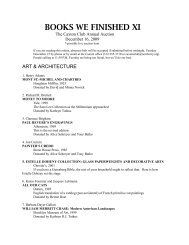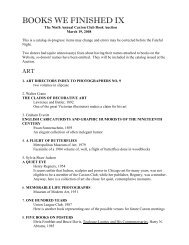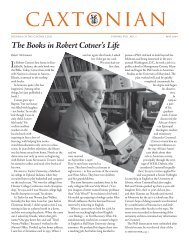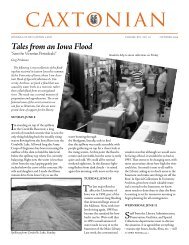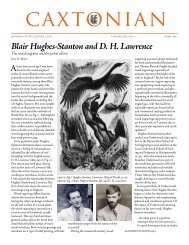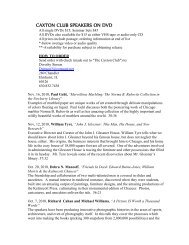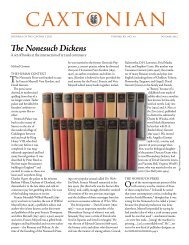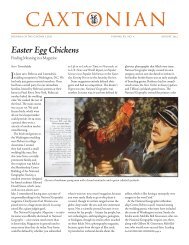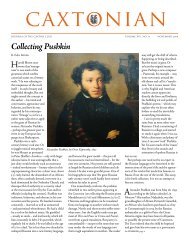July - The Caxton Club
July - The Caxton Club
July - The Caxton Club
Create successful ePaper yourself
Turn your PDF publications into a flip-book with our unique Google optimized e-Paper software.
large-scale study where the results indicated<br />
that, surprisingly, drugs used to save<br />
lives were associated with a higher mortality<br />
than a placebo. In scientific investigation,<br />
plausibility is important in testing<br />
hypotheses, but plausibility depends upon<br />
a rational view of the universe. If you<br />
believe in witchcraft and the supernatural,<br />
plausibility expands immensely. Plausibility<br />
is a weak link in the chain of hypothesis<br />
testing, along with bias in collecting<br />
data. In terms of my experience, from the<br />
same study, it was biologically plausible<br />
that a drug that decreased abnormal heart<br />
rhythms in people with underlying heart<br />
disease would save lives. In fact, it was<br />
more dangerous.<br />
Sherlock Holmes’ method of collecting<br />
A Paget illustration used<br />
start our speculation.”<br />
As for the oblique uses of knowledge,<br />
Holmes built compendia on<br />
arcane subjects. He was an expert<br />
on tobacco ashes, poisons, the<br />
characteristics of special soils, the<br />
appearance of hands with respect<br />
to the trade of their bearers, and<br />
writings. In “<strong>The</strong> Adventure of the<br />
Reigate Squire,” for example, he<br />
analyzes a written communication<br />
of several sentences, concluding that<br />
each word was written alternatively<br />
by a younger and an older man,<br />
probably blood relations, father<br />
and son. He concludes the different<br />
ages by the strong hand of half<br />
the words, and the “broken backed”<br />
information frequently mystifies in the first appearance of<br />
appearance of the other half, with<br />
Scotland Yard inspectors calling for his “A Scandal in Bohemia.”<br />
the loss of crossing of the “t’s” and<br />
assistance, as well as Watson. In the very<br />
first novelette, A Study in Scarlet, Holmes and<br />
Watson are called to investigate a murder in<br />
a vacant house in London. <strong>The</strong> dead body<br />
is present in one of the rooms. Watson, not<br />
yet knowing Holmes well, expects that he<br />
would “at once have hurried into the house<br />
and plunged into the study of the mystery.”<br />
However, Holmes slowly and nonchalantly<br />
assesses the surroundings of the house,<br />
including the pavement, railings, sky, and<br />
opposite houses. Satisfied, he finally enters the<br />
house and spends the better part of an hour<br />
examining not only the body, but the dust on<br />
the floor, scratch marks on the wall in which a<br />
bloody word, “RACHE,” is inscribed, and in<br />
the meantime, using a tape measure. Holmes<br />
deduces that the murderer was a man, that he<br />
smoked a particular brand of cigar (from the<br />
type of cigar ash on the floor), that he came<br />
with his victim in a four-wheeled cab, that he<br />
had a florid face susceptible to nosebleeds (no<br />
blood or wound was present on the victim<br />
to account for the bloody word on the wall)<br />
and that the fingernails of his right hand were<br />
remarkably long (from the scratch marks near<br />
the bloody letters). However, he needed something<br />
more than observation to conclude that<br />
the word “RACHE” was not an uncompleted<br />
woman’s name, but the German word for<br />
revenge. This took imagination, or intuition, a<br />
leap from analysis alone.<br />
Many analyses have been performed on<br />
Holmes’ techniques. It is too bad that the<br />
Whole Science of Deduction, which Holmes<br />
was to write in his retiring years, was never<br />
compiled by Conan Doyle. Although it is<br />
commonly assumed that deduction is the<br />
main factor in Holmes’ systematic approach,<br />
most of his case analysis starts with inductive<br />
reasoning. It is used to develop hypotheses as<br />
to why a bloody fingerprint appears on a wall<br />
after the crime is committed, why a sailor’s<br />
knot is used to tie up a victim, and why one<br />
of three empty glasses of port has no dregs.<br />
<strong>The</strong> hypotheses produced from inductive<br />
reasoning lead to testing of these hypotheses<br />
by deduction. In A Study in Scarlet, Holmes<br />
states: “By the method of exclusion, I had<br />
arrived at this result, for no other hypothesis<br />
would meet the facts.” Holmes characteristically<br />
used the word “hypothesis” to describe<br />
this aspect of his reasoning, rather than the<br />
term “induction.” In “Silver Blaze”: “I have<br />
already said that he must have gone to King’s<br />
Pyland or to Mapleton. He is not at King’s<br />
Pyland. <strong>The</strong>refore he is at Mapleton. Let us<br />
take that as a working hypothesis and see<br />
what it leads us to.” In “<strong>The</strong> Adventure of the<br />
Copper Beeches,” he remarks “I have devised<br />
seven separate explanations, each of which<br />
would cover the facts as far as we know them.<br />
But which of these [hypotheses] is correct can<br />
only be determined by the fresh information<br />
which we will no doubt find waiting for us.”<br />
Sherlock Holmes’ thought processes may<br />
be summarized in sequence as observation,<br />
analysis, and imagination. As to the last,<br />
Holmes states in “<strong>The</strong> Valley of Fear” that<br />
“Breadth of view…is one of the essentials of<br />
our profession.” In <strong>The</strong> Hound of the Baskervilles,<br />
he comments directly on the importance<br />
of imagination in his deductions. “[We are<br />
coming] into the region where we balance<br />
probabilities and choose the most likely. It is<br />
the scientific use of the imagination, but we<br />
have always some material basis on which to<br />
absence of the “i” dots in the latter<br />
reinforcing older age in one of the writers. <strong>The</strong><br />
blood relationship of the two writers is determined<br />
by the similarity of the peculiar writing<br />
of the letter “e,” and the tails of some of the<br />
other letters.<br />
Holmes makes a particular point of distinguishing<br />
analytical from synthetic reasoning.<br />
From A Study in Scarlet: “<strong>The</strong> grand thing is<br />
to reason backward… <strong>The</strong>re are fifty who can<br />
reason synthetically for one who can reason<br />
analytically. Most people, if you describe a<br />
train of events to them, will tell you what the<br />
result would be. <strong>The</strong>re are few people, however,<br />
who, if told them a result, would be able to<br />
evolve from their own inner consciousness<br />
what the steps were which led up to the result.<br />
This power is what I mean when I talk of reasoning<br />
backward, or analytically.”<br />
This is seen in the design of studies, well<br />
beyond Holmes’ time, in what is called a casecontrol<br />
study. In clinical medicine, a group of<br />
patients is in the hospital with a certain condition.<br />
What is a risk factor for this condition<br />
A hypothesis is generated that a cause leads to<br />
this condition. How can you test this hypothesis<br />
by reasoning backward <strong>The</strong> answer is to<br />
take another group of patients hospitalized in<br />
the same location, of the same age, and with<br />
similar physical findings, except for the disease<br />
investigated, and determine the presence of<br />
risk factors in the past history of each group.<br />
If the putative causes of the disease are present<br />
in a statistically greater amount in the study<br />
group, compared with the non-diseased group,<br />
a cause-and-effect relationship is suggested.<br />
A well-known example of Holmes’ deductive<br />
reasoning is found in “Silver Blaze,” when<br />
See SHERLOCK HOLMES, page 4<br />
CAXTONIAN, JUly 2010



